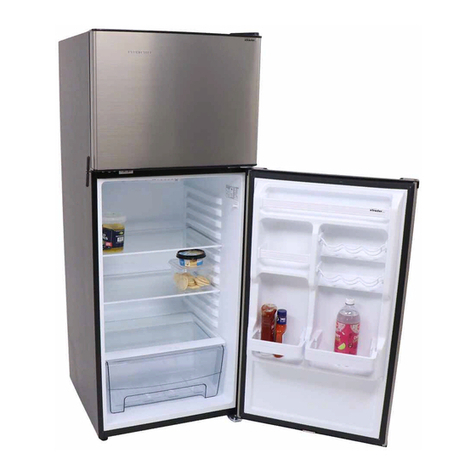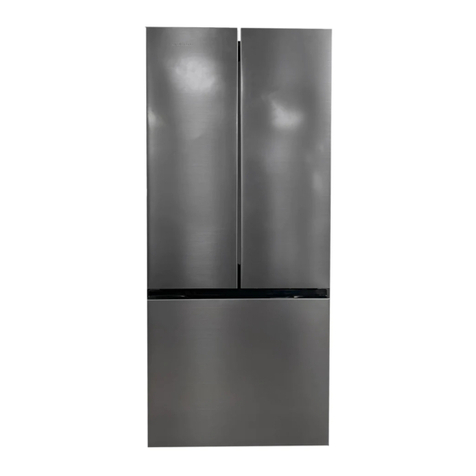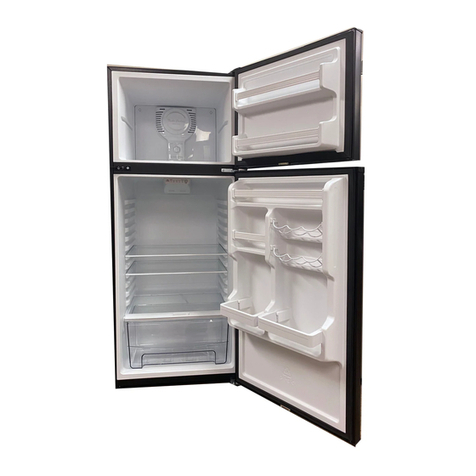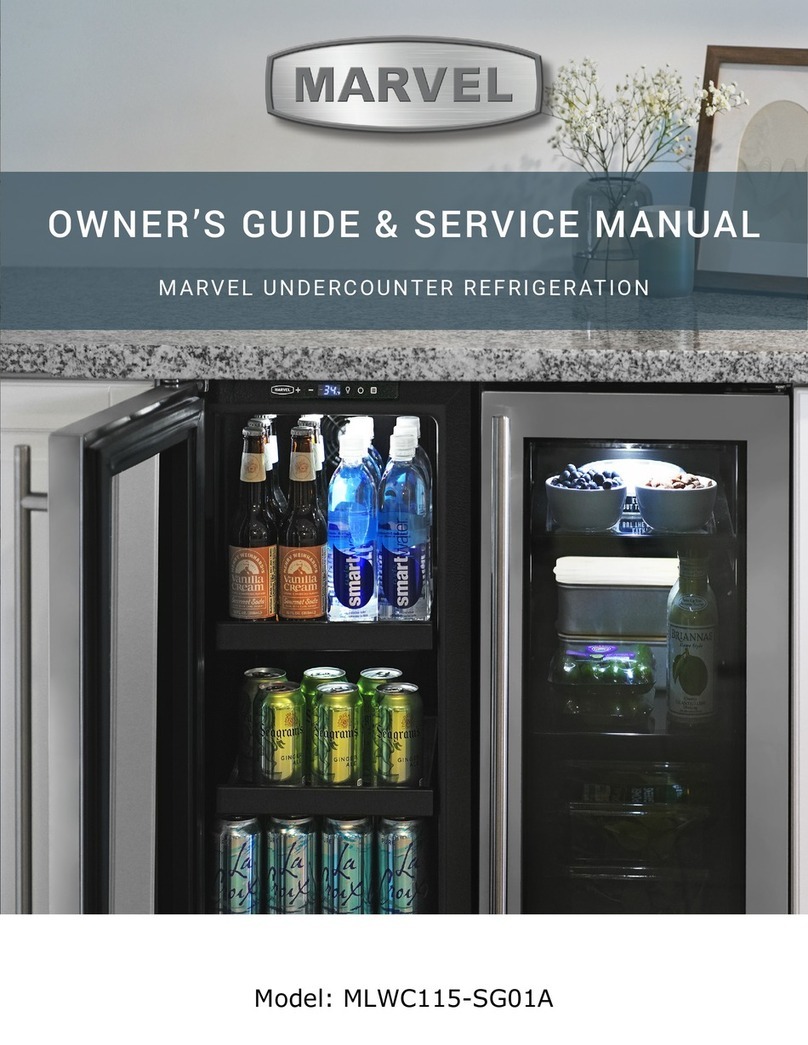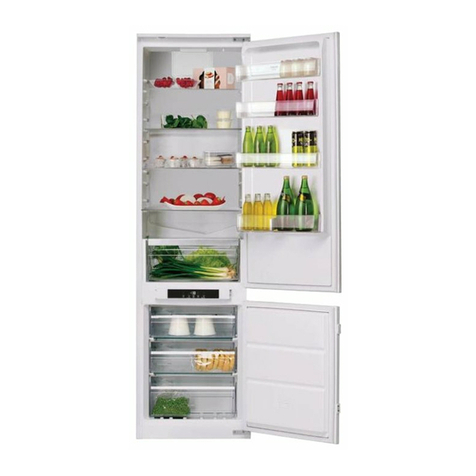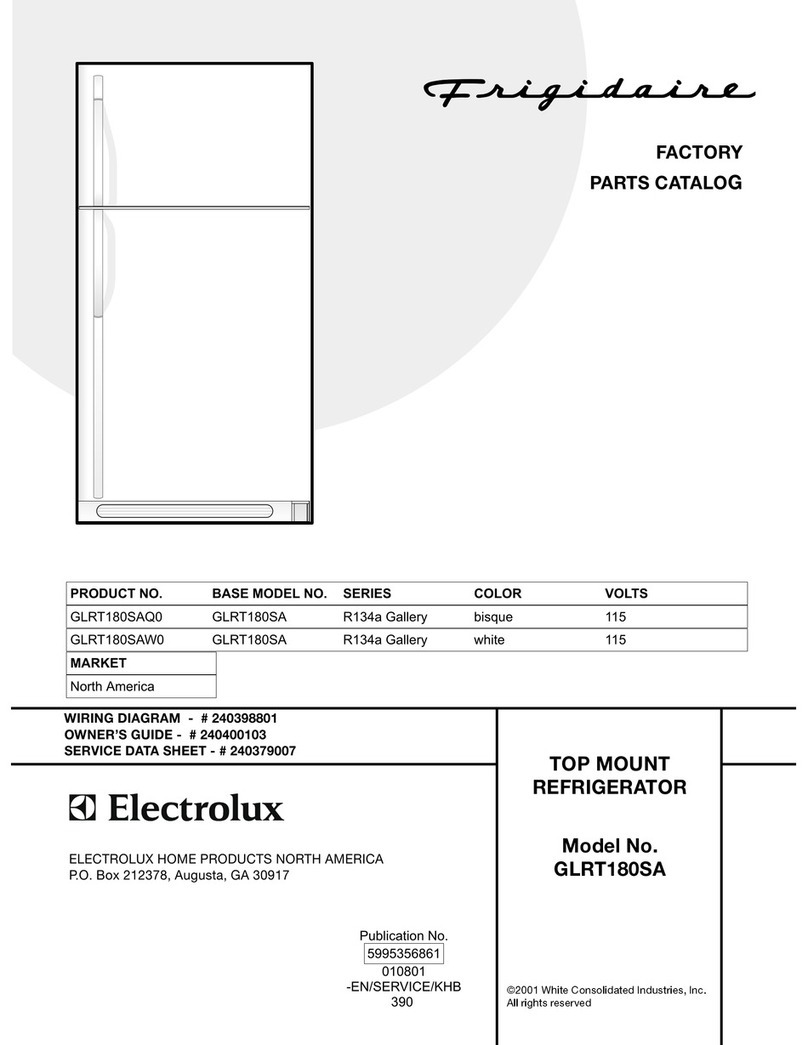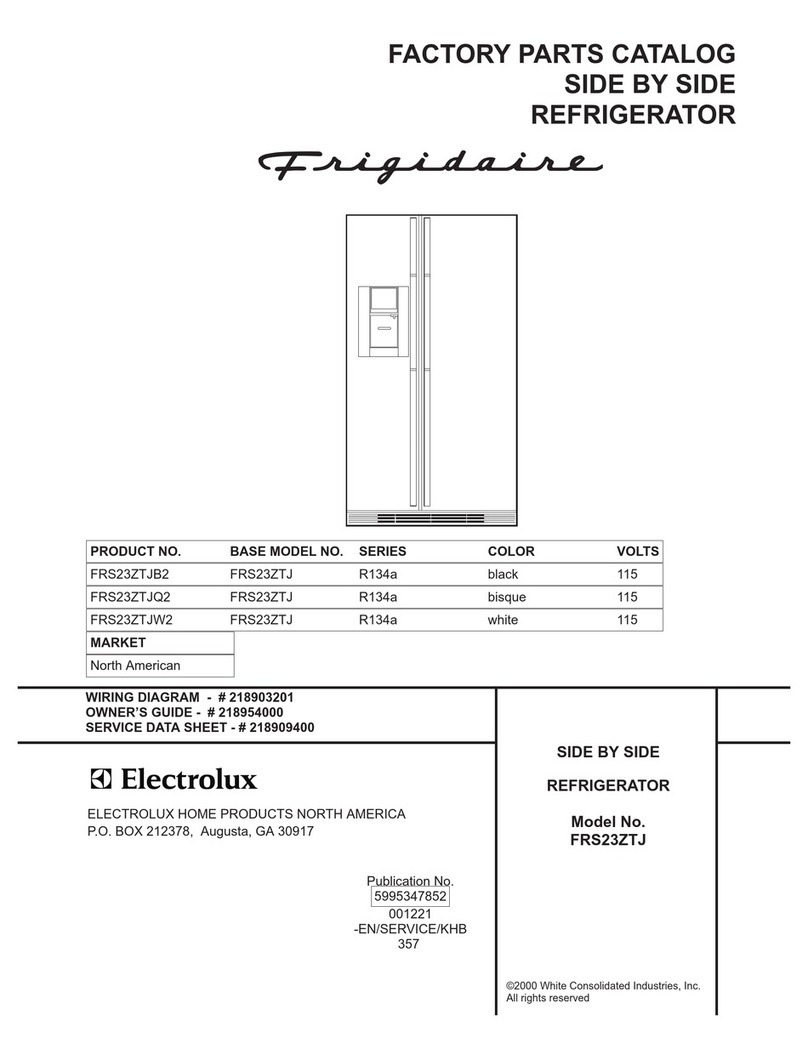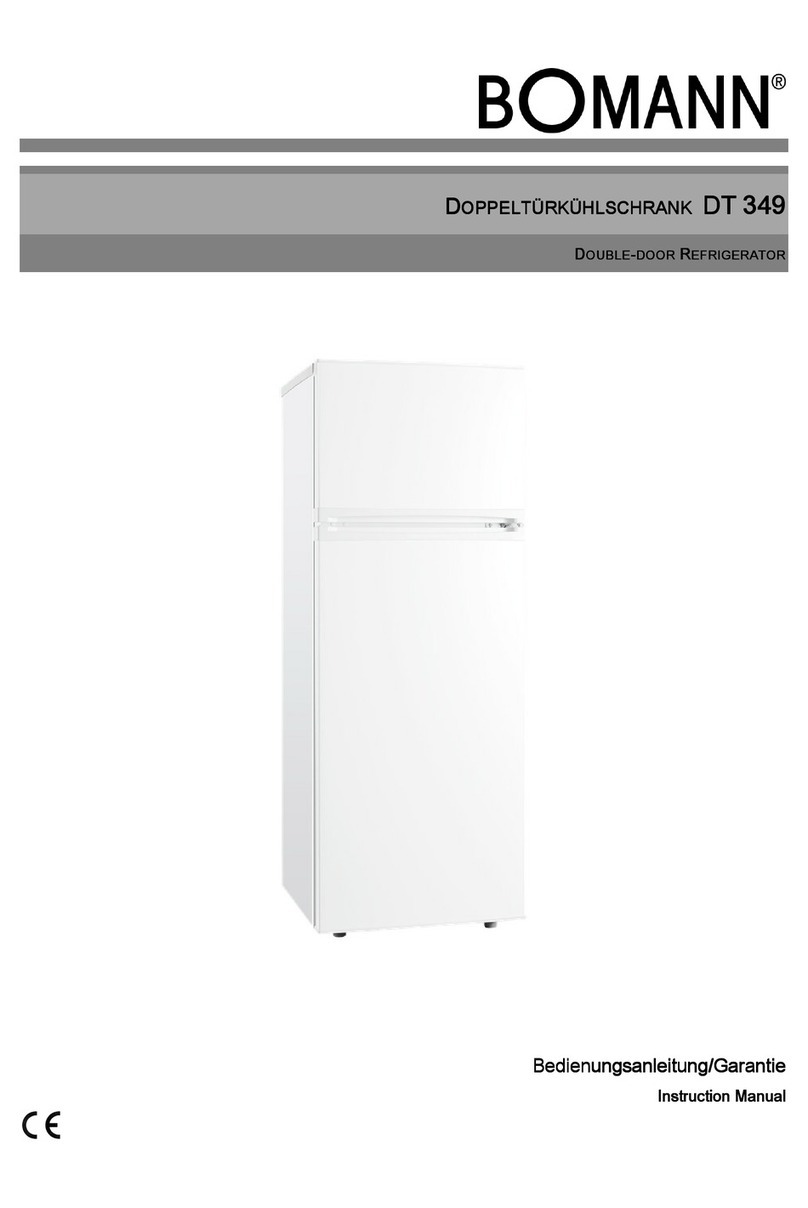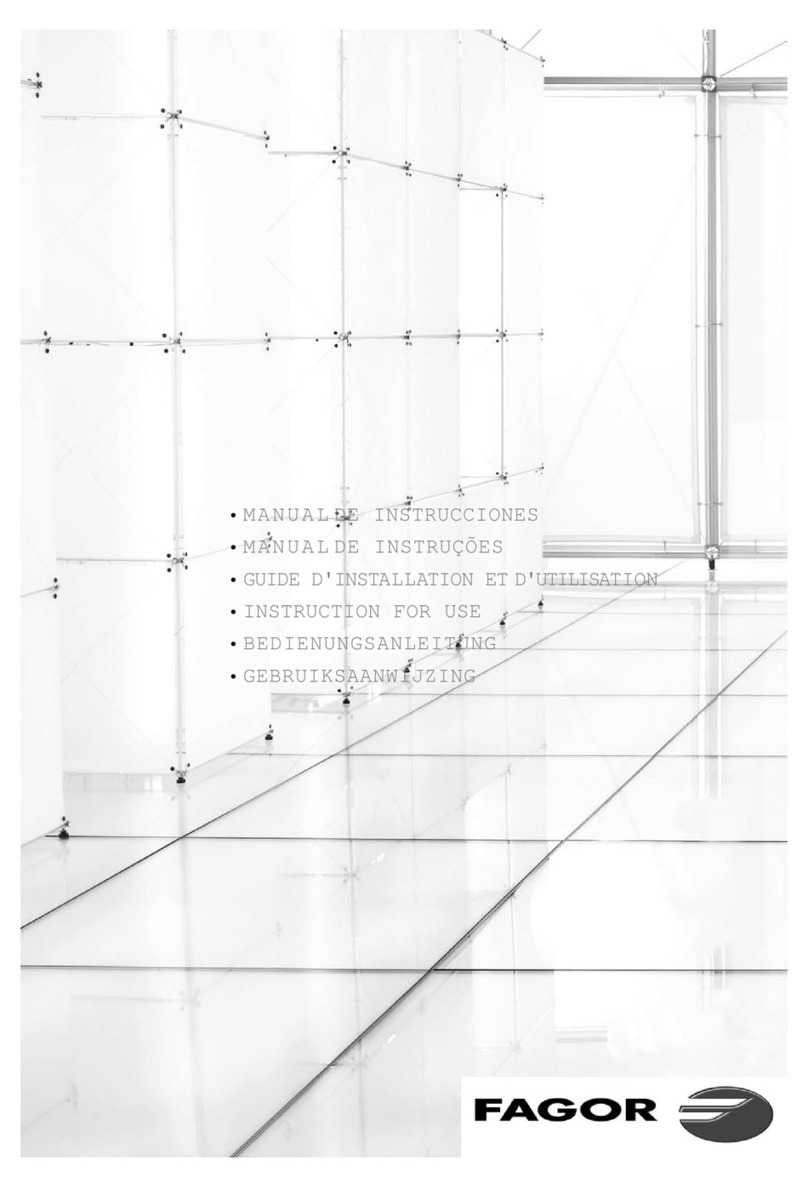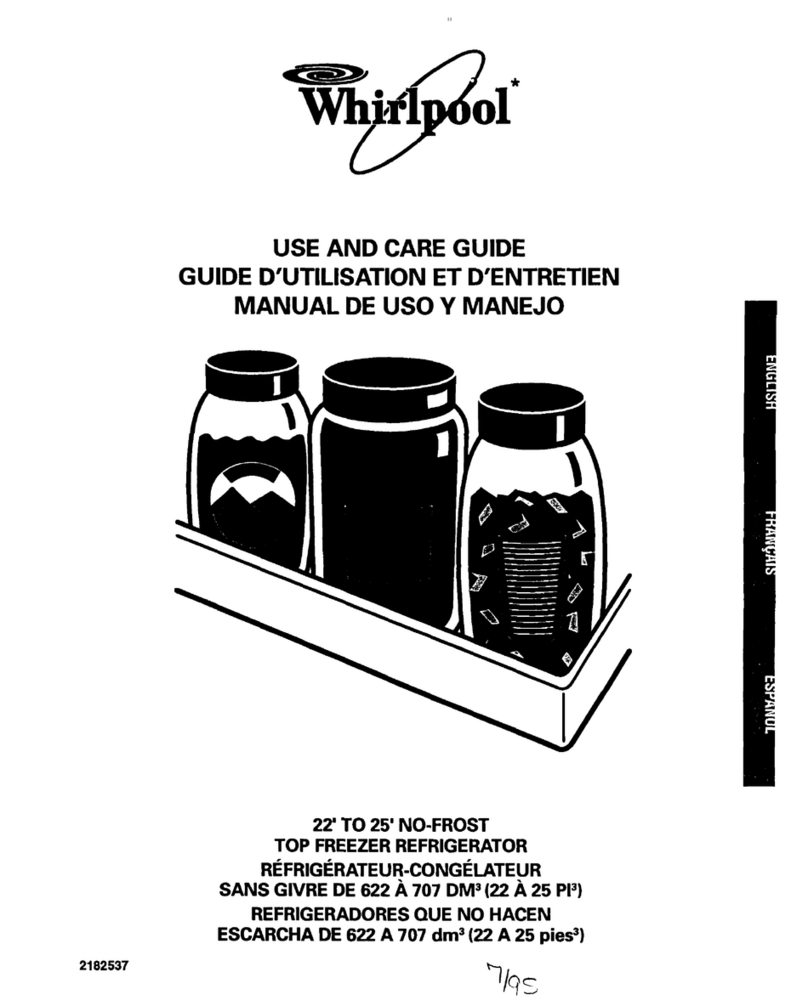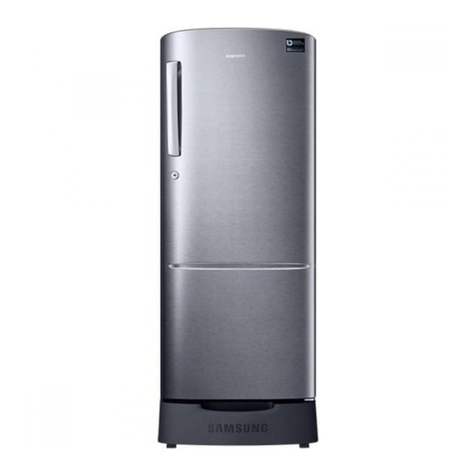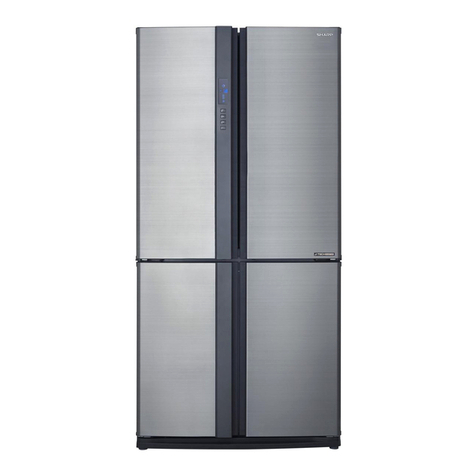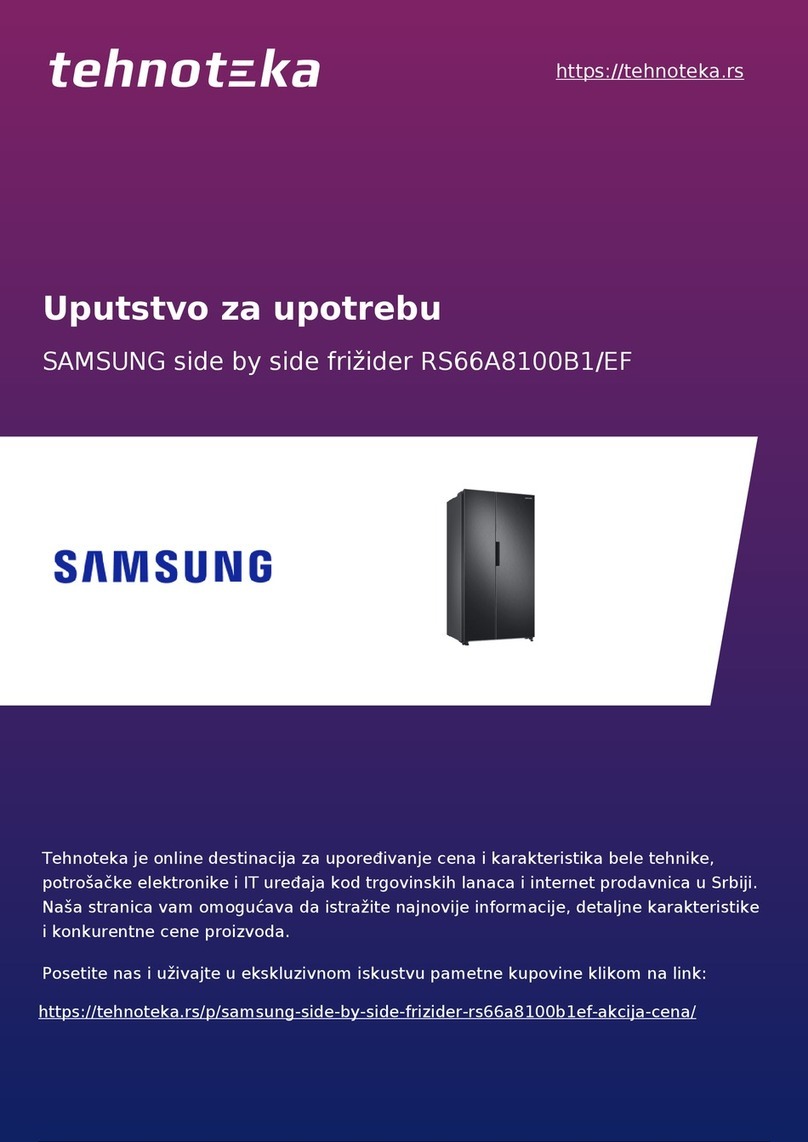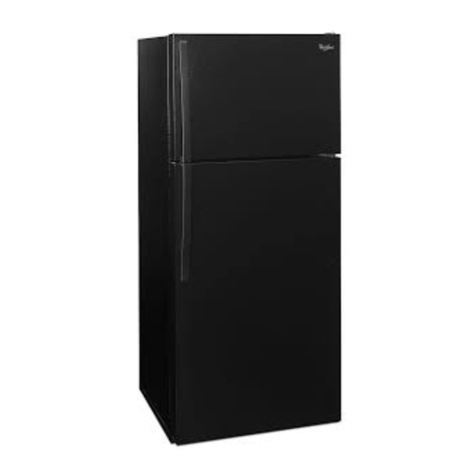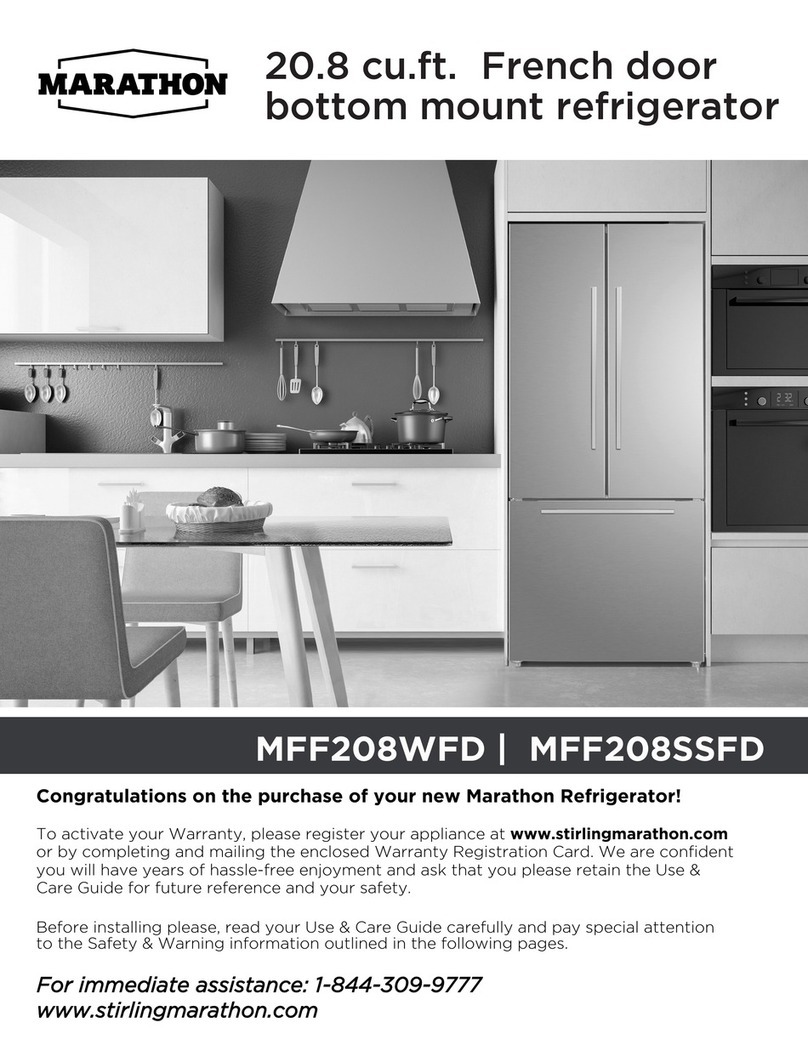Everchill SRD-360WTG-E User manual

Built-in Vehicle
FROST-FREE REFRIGERATOR-FREEZER
INSTRUCTION MANUAL
Model No.: SRD-360WTG-E
Dear users, this manual contains the product's basic knowledge, how to use it,
fault diagnosis and basic troubleshooting methods. In order to better
understand and use this product, please take good care of this manual, and read
it carefully.


1
CONTENTS
I. IMPORTANT SAFETY INSTRUCTIONS....................................................................................................................2
II. FEATURES AND PARTS........................................................................................................................................ 4
III. PREPARATIONS FOR USE.................................................................................................................................... 4
IV. FUNCTIONS.......................................................................................................................................................... 6
V. INSTRUCTIONS FOR FOOD STORAGE.................................................................................................................. 8
VI. TIPS FOR SPECIAL NEEDS.................................................................................................................................. 9
VII. MAINTENANCE AND CLEANING....................................................................................................................... 10
VIII. SIMPLE FAULT ANALYSIS AND ELIMINATION................................................................................................. 11

2
I. IMPORTANT SAFETY INSTRUCTIONS
WARNINGS
1. Read these instructions.
2. Keep these instructions.
3. Heed all warnings.
4. Follow all instructions.
5. Do not use your refrigerator near water.
6. Clean only with a damp cloth.
7. Do not block any ventilation openings. Install in accordance with the manufacturer's instructions.
8. Do not install near any heat sources, such as radiators, heat registers, stoves, or other apparatus (including
amplifiers) that produce heat.
9. Refer all servicing to qualified service personnel. Servicing is required when your refrigerator has been damaged in
any way, such as liquid has been spilled or objects have fallen into your refrigerator, your refrigerator has been
exposed to rain or moisture, does not operate normally, or has been dropped.
10. To reduce the risk of fire or electric shock, do not expose your refrigerator to rain, moisture, dripping, or splashing,
and no objects filled with liquids should be placed on top of it.
11. Your refrigerator is not intended for use by persons (including children) with reduced physical, sensory, or mental
capabilities, or lack of experience and knowledge, unless they have been given supervision or instruction concerning
use of your refrigerator by a person responsible for their safety.
12. Children should be supervised to ensure that they do not play with your refrigerator.
ELECTRIC SHOCK HAZARD
Failure to follow these instructions can result in electric shock, fire, or death.
1.WARNING–Keep ventilation openings, in both your refrigerator and the built-in structure, clear of obstruction.
2.WARNING–Do not touch the interior of your refrigerator with wet hands. This could result in
frostbite.
3.WARNING–Do not use mechanical devices or other means to accelerate the defrosting process, other than those
recommended by the manufacturer.
4.WARNING–Do not damage the refrigerant circuit.
5.WARNING–Do not damage the refrigerant tubing when handling, moving, or using your refrigerator.
6.WARNING–DANGER-Never allow children to play with, operate, or crawl inside your refrigerator.
Risk of child entrapment. Before you throw away your old refrigerator:
• Take off the door.
• Leave the shelves in place so that children may not easily climb inside.

3
7. WARNING-Do not use electrical appliances inside the food storage compartments of the appliance unless they are of
the type recommended by the manufacturer.
8.Power source disconnected your refrigerator before carrying out user maintenance on it.
9.If a component part is damaged, it must be replaced by the manufacturer, its service agent, or similar qualified persons
in order to avoid a hazard.
10.Follow local regulations regarding disposal of your refrigerator due to flammable refrigerant and gas. All refrigeration
products contain refrigerants, which under the guidelines of federal law must be removed before disposal. It is the
consumer's responsibility to comply with federal and local regulations when disposing of this product.
11. Do not store explosive substances such as aerosol cans with a flammable propellant in this appliance.
12. This appliance is intended to be used in the recreational vehicle.
13. This appliance is intended to be used in recreational vehicle.
POWER SOURCE REQUIREMENT
This appliance is Class III appliances, it must only be supplied at safety extra low voltage.
It should have a circuit breaker for full disconnection from the appliance and power supply mains.
Before using, the appliance should be disconnected from main power supply, and conduct wiring connections by
reference to the wiring diagram.
Do not connect the unit to AC power supply.
1. In order for normal use, the connection must be reliable. Besides the power source roper connection, the wire of the
unit and outer wire must meet the following requirement:
Wire size The max length (Feet)
14 AWG 3.2 Feet
13 AWG 8 Feet
12 AWG 13 Feet
10 AWG 20 Feet
8 AWG 33 Feet
6 AWG 50 Feet
Remarks 14 AWG wire is not recommended. 13 AWG wire or larger is recommended.
This DC unit is not equipment with a power source. Please purchase a power
source from an authorized dealer.
2. When using an adaptor or converter AC to DC, No DC power supply is recommended.
3. It is recommended that only authorized or qualified professionals perform repair services on unit.
WIRE CONNECTION DIAGRAM
1. Connect ①terminal with Positive pole of 12V DC.
2. Connect ②terminal with Negative pole of 12V DC.
3. If the unit is installed in an RV, the ③GND terminal should be connected directly to the RV chassis..

4
II. Features and parts
Due to technological innovations, the product descriptions in this manual may not be completely consistent with
your refrigerator. Detailed information is in accordance with the final product.
III. Preparations for use
Installation location:
1. Ventilation condition
The position you select for the refrigerator installation should be well-ventilated and has less hot air. Do not locate the unit
near a heat source such as cooker, and avoid it from direct sunlight, thus guaranteeing the refrigerator effect while saving
energy consumption. Do not locate the refrigerator in the damp place, so as to prevent it from rusting and leaking
electricity.
Note: The amount of refrigerant charged for the unit can be found on the nameplate.
2. Heat dissipation space
When working, the unit gives off heat to surroundings. Therefore, at least 300mm(11.8”)of free space should be spared
at the top side, more than 100mm(3.9’’) on both sides, and above 50mm(2”)at the side of the refrigerator.
Dimensions in mm:
W D H A B C(°)E F
606.5(23.9’’)
672(26.5”) 1516(59.7’’) 1034(40.7’’) 1226(48.3’’) 122±350(2’’) 100(3.9’’)
Fig. 1 Fig. 2
Note:Figure 1, Figure 2 only illustrate the space demand of the product.

5
3. Level ground
Place the refrigerator on the solid and flat ground (floor) to keep it stable, or else, it will give rise to vibration and noise.
When the refrigerator is placed on such flooring materials as carpet, straw mat, polyvinyl chloride, the solid backing plates
should be applied underneath the unit, so as to prevent color change due to heat dissipation.
4. Fixing the refrigerator to the closet
The user can install the screw into the holes on the inner cabinet to fix the refrigerator to the RV closet, pls see below
photos:
5. Fixing the glass shelves in the refrigerator room and freezer room
The glass shelves in the refrigerator room and freezer room will be fixed in the production. For the safety consideration,
the glass shelves are prohibited to move.
Unobstructed ventilation shall be maintained around the unit or in an embedded structure.
Preparations for use
1. Standing time
After the refrigerator is properly installed and well cleaned, do not switch it on immediately. Make sure to energize the
refrigerator after more than 1 hour's standing, so as to ensure its normal operation.
2. Cleaning
Confirm the accessory parts inside the refrigerator and wipe the inside with a soft cloth.
3. Power-on
Connect the refrigerator power supply to the dedicated power supply battery in the RV, then the compressor starts
working. After 1 hour, open the freezer door, if the compartment internal temperature drops significantly, it indicates the
refrigeration system is working normally.
4. Storage of food
After the refrigerator runs for a period of time, the internal temperature of the refrigerator will be automatically controlled
according to the user's temperature setting. After the refrigerator is fully cooled, put in foods, which usually need 2~3
hours to be fully cooled. In summer, when the temperature is high, it takes more than 4 hours for the foods to be fully
cooled (Try to open the refrigerator door as less as possible before the internal temperature cools down).
When used in an ambient temperature of higher than 50 ℃, in order to guarantee the service life and
function of the electronic components of the refrigerator, it may not get started at the first time or not be cooling.

6
IV. Functions
When the refrigerator system is connected to the power supply for the first time, all icons on the display panel gets
illuminated for 3s.
1. Functions
1.1 Temp. setting
“SET” is the key to set temperature mode. Every time when this key is pressed, the current indicator light will be off, with
the next indicator light illuminated; and when the door is closed, the temperature mode setup will be validated. Once the
setting takes effect, the temperature will be controlled accordingly, with the corresponding indicator light normally ON.
The temperature setting progresses through the following cycle: 1→2→3→4→5→1→2→3→4→5.
If your refrigertor is installed in too low or high temperature, the internal cooling system may not work correctly.
1.2 Power Off
1)After the “Power Off” function of the refrigerator is enabled, the mode indicator lights "2" and "3" will be on. When the
refrigerator is at “Power Off” state, the lighting lamp will be off, with no cooling and defrosting action to be performed.
Users can set this function when they are on holiday for a short time.
Before setting this function, be sure to take out all the items in the refrigerator!
2)To enable the “Power Off” function:
Press and hold down the ‘SET’ button for 10s.
3)To exit the “Power Off” function:
When the ‘Power Off’ function is active, press and hold down the ‘SET’ button for 10s.

7
1.3 Battery Monitor
1) The “Battery Monitor” function can display the current input voltage value of the refrigerator, helping the user
understand the current battery level.
2) Enable the "Battery Monitor” function:
Press and hold down the “SET” button for more than 5 seconds (but within 10 seconds);
3) Exit the "Battery Monitor" function:
After the "Battery Monitor" function is activated, press the “SET” shortly then can exit the function
4) After the “Battery Monitor” function is enabled, the current input voltages of the refrigerator will be indicated as below:
Voltage values Indicators
<10V “1” FLASHING
10V - 11V “2” FLASHING
11V - 12V “3” FLASHING
12V - 13V “4” FLASHING
≥13V “5” FLASHING
1.4 Power cut memory
In case of power outage, the refrigerator will maintain the running state that is set before power failure after the
power recovery.
1.5 Power-on delay
In order to protect the refrigerator compressor from being damaged in the case of short-time power failure, the
compressor will start after it is powered on for 5 minutes.
1.6 Overvoltage or undervoltage protection
In order to prevent damage to the refrigerator and the battery itself caused by abnormal or insufficient battery voltage,
the refrigerator is designed with undervoltage and overvoltage protection function, so that the refrigerator will be
compulsorily powered off or the compressor will be shut down for protection once this function is activated, with the
corresponding alarm indicator ON. (See the following self-checking function table)
1.7 Self-checking function
1) The refrigerator is designed with self-checking function. In case of failure, the indicator will be flashing for alarm
purpose.
2) Indicator alarm rules are as follows:
S/N Fault Display Item Information
1 Fridge sensor fault Indicator light “1”keeps flashing
2 Ambient temp. sensor fault Indicator light “2”keeps flashing
3 Freezer defrosting sensor fault Indicator light “3”keeps flashing
4 Undervoltage alarm Indicator light “4”keeps flashing
5 Overvoltage Indicator light “5”keeps flashing
6 Fan failure Indicator light “1”and “3”keeps flashing
3) When the refrigerator indicator lights are flashing in the above manner, please contact for maintenance;

8
V. Instructions for food storage
Precautions for use
The appliance might not operate consistently (there is possibility of defrosting or temperature becoming too warm in
the frozen food compartment) when sited for an extended period of time below the cold limit of the temperature
range for which the refrigerating appliance is designed
The information of climate type of the appliance is provided on the rating plate.
The internal temperature could be affected by such factors as the location of refrigerating appliance, ambient
temperature, and frequency of door open, etc., and if appropriate, a warning that setting of any temperature control
device might have to be varied to allow for these factors should be made.
Effervescent drinks should not be stored in the freezer compartment or the low-temperature compartment.
Food storage location
Due to the cold air circulation in the refrigerator, the temperature of each area in the refrigerator is different, so different
kinds of food should be placed in different areas.
The fresh food compartment is suitable for the storage of such foods as need not to be frozen, the cooked food, beer,
eggs, some condiments that need cold preservation, milk, fruit juice, etc. The crisper box is suitable for the preservation of
vegetables, fruits, etc.
The freezer compartment is suitable for the storage of ice cream, frozen food and the foods to be preserved for a long
time.
Use of the fresh food compartment
Set the temperature of the fresh food storage compartment between 1 ℃~ 6 ℃, and store the foods that are intended
for short-term storage, or to be eaten at any time in the fresh food compartment.
Fridge shelf: When removing the shelf, lift it up first, and then pull it out; and when installing the shelf, place it into position
before putting it down. Keep the shelf rear flange upward, to prevent foods from contact the liner wall. When taking out or
putting in the shelf, hold it firmly, and handle with care to avoid damage.
Crisper box: Pull out the crisper box for access to food. After using or cleaning the cover plate of the crisper box, be sure
to put it back onto the crisper, so that the internal temperature of the crisper box will not be affected.
Cautions for food storage
You'd better clean the foods and wipe them dry before storing them inside the refrigerator. Before foods are put in the
refrigerator, it is advisable to seal them up, so as to prevent water evaporation to keep fresh fruits and vegetables on one
hand, and prevent taint of odor on the other hand.
Do not over pack the refrigerator compartment. Keep enough space between foods; if too close, the cold air flow will be
blocked, thus affecting the refrigeration effect. Do not store excessive or overweight foods, to avoid the shelf from being
crushed. When storing the foods, keep a distance away from the inner wall; and do not place the water-rich foods too
close to the fridge rear wall, lest they get frozen on the inner wall.
Categorized storage of foods:Foods should be stored by category, with the foods you eat every day placed in front of the
shelf, so that the door open duration can be shortened and food spoilage due to expiration can be avoided.
Energy-saving tips: Allow hot food to cool down to room temperature before putting it in the refrigerator. Put the frozen
food in the fresh food compartment to thaw, using the low temperature of the frozen food to cool the fresh food, thus
saving energy.
Storage of fruits and vegetables
In the case of refrigerating appliances with chill compartment, a statement to the effect that some types of fresh
vegetables and fruits are sensitive to cold and therefore are not suitable for storage in this kind of compartment should be
made.
Use of the frozen food storage compartment
The freezer temperature is controlled below -16 ℃, and it is advisable to store the food for long-term preservation in the
freezer compartment, but the storage duration indicated on the food packaging should be adhered to.
The freezer drawers are used to store food that needs to be frozen. Fish and meat of large block size should be cut into
small pieces and packed into fresh-keeping bags before they are evenly distributed inside the freezer drawers.
Energy saving tips
·Let hot foods cool to room temperature before placing in the refrigerator.
·Be sure to wrap foods properly, and wipe container dry before placing them in the refrigerator. This cuts down on frost
build-up inside the refrigerator.
·Organize and label food to reduce door openings and extended searches.
Tips for shopping the frozen foods
1. When you are buying frozen food, look at the Storage Guidelines on the packaging. You will be able to store each
item of frozen food for the period shown against the star rating. This is usually the period stated as “Best to use them
before×”, found on the front of the packaging.
2. Check the temperature of the frozen food cabinet in the shop where you buy the frozen foods.
3. Make sure the frozen food package is in perfect condition.
4. Always buy frozen products last on your shopping trip or visit to the supermarket.
5. Try to keep frozen food together whilst shopping and on the journey home, as this will help to keep the food cooler.
6. Don't buy frozen food unless you can freeze it straight away. Special insulated bags can be bought from most
supermarkets and hardware shops. These keep the frozen foods cold longer.
7. For some foods, thawing before cooking is unnecessary. Vegetables and pasta can be added directly to boiling
water or steam cooked. Frozen sauces and soups can be put into a saucepan and heated gently until thawed.

9
8. Use quality food and handle it as little as possible. When foods are frozen in small quantities, it will take less than for
them to freeze up and thaw.
9. Estimate the amount of foods to be frozen up. When freezing large amounts of fresh food, adjust the temperature
control knob to the low mode, with the freezer temperature lowered. So, foods can be frozen up in fast manner, with the
food freshness well kept.
VI.Tips for special needs
Moving the refrigerator/freezer
•Location
Do not place your refrigerator/freezer near a heat source, e.g. cooker, boiler or radiator. Avoid it from direct sunlight in
out-buildings or sun lounges.
•Leveling
Make sure to level your refrigerator/freezer using the front leveling feet. If not level, the refrigerator/freezer door gasket
sealing performance will be affected, or even it may lead to the operating failure of your refrigerator/freezer.
After locating the refrigerator/freezer in position, wait for 4 hours before using it, so as to allow the refrigerant to settle.
•Installation
Do not cover or block the vents or grilles of your appliance.
When you are not in the RV for a long time
•If the appliance will not be used for several months, turn it off first, and then disconnected the power source.
•Take out all foods.
•Clean and dry the interior thoroughly. To prevent odor and mold growth, leave the door ajar: block it open or have the
door removed if necessary.
•Keep the cleaned appliance in a dry, ventilated place and away from the heat source, place the appliance smoothly, and
do not place heavy objects on top of it.
•The unit should not be accessible to child's play.

10
VII. Maintenance and cleaning
When cleaning, Do not stretch your hands into the bottom of the refrigerator, since you might be scratched
by sharp metal corners.
Internal cleaning and external cleaning
The food residuals in the refrigerator are liable to produce bad odor, so the refrigerator must be cleaned regularly. The
fresh food compartment is usually cleaned once a month.
Remove all shelves, crisper box, bottle racks, cover board, and drawers etc., and clean them with a soft towel or sponge
dipped in warm water or neutral detergent.
Clear off the dusts accumulated on the rear panel and side plates of the refrigerator often.
After using detergent, be sure to rinse it with clean water, and then wipe it dry.
Do not use bristle brush, steel wire brush, detergent, soap powder, alkaline detergent, benzene, gasoline,
acid, hot water and other corrosive or soluble items to cleanse the cabinet surface, door gasket, plastic
decorative parts, etc., so as to avoid damage.
Carefully wipe dry the door gasket, clean the groove. After the cleaning, fix the four corners of the door gasket first, and
then embed it segment by segment into the door groove.
Interruption of power supply or failure of the refrigerating system
•Take care of the frozen foods in the event of an extended non-running of the refrigerating appliance (such as interruption
of power supply or failure of the refrigerating system).
•Try to open the refrigerator door as least as possible, this way food can safely and freshly be kept for hours even in hot
summer.
•If you get the power outage notice in advance:
1) Adjust the thermostat knob to the high mode an hour in advance, so that foods get fully frozen (Do not store new
food during this time!). Restore the temperature mode to the original setting when power supply becomes normal in a
timely manner.
2) You can also make ice with a watertight container, and put it in the upper part of the freezer, so as to extend the time
for fresh food to be stored.
Defrosting
This appliance is designed with automatic defrosting function, thus no need to defrost it manually.
Changing the lamp
The LED lamp is used by the refrigerator for lighting, which features low energy consumption and long service life. In case
of any abnormality, please contact the after-sales personnel service.
How to disassemble the parts.
Fridge door bottle rack:
Hold the bottle rack with both hands, and then push it up.
Push

11
VIII. Simple fault analysis and elimination
You can solve many common refrigerator problems easily, saving you the cost of a possible service call.
Try the suggestions below to see if you can solve the problem before calling for service.
Case Inspection Solutions
·Completely non-
refrigeration
• Power source connected is OK?
•Are breakers and fuses broken?
•No electricity or line trip?
• Refer to the wiring diagram, check the power wiring
connection.
•Opening the door and checking whether the lamp is
lit.
• Check fuse
Abnormal noise
•Is refrigerator stable?
•Does refrigerator contact the wall?
•Adjusting refrigerator's leveling feet.
•Off the wall.
·Poor refrigerating
efficiency
•Do you put hot food or too much food?
•Do you open the door frequently?
•Do you clip food bag to the door gasket?
•Direct sunlight or near a furnace or stove?
•Is it well-ventilated?
•Temperature setting in too high?
•Putting food into refrigerator when hot food
becomes cool.
•Checking and closing the door.
•Removing the refrigerator from the heat source.
•Emptying the distance to maintain good
ventilation.。
•Setting to the appropriate temperature.
·Peculiar smell in
refrigerator
•Any spoiled food?
•Do you need to clean refrigerator?
•Have you packed food of strong flavors?
•Throwing away spoiled food.
•Cleaning refrigerator.
•Packing food of strong flavors.
Refrigerator not
cooling;
Are indicator lights “2” and “3” on? Is the
‘Power Off' function activated?
Press the corresponding key to exit the ‘Power Off'
function.
Compressor
fault ;
Does the battery have sufficient electricity?
1) Check if the battery power ever falls below 9V, it
may lead to the compressor undervoltage protection,
charge or replace the battery if necessary.
2) If the battery level is high (above 11V), or the
battery with sufficient power has been replaced, wait
for 5 minutes to observe whether it can return to
normal; if not, please contact the after-sales
personnel for service.
( Note: If the above descriptions are inapplicable to troubleshooting, do not disassemble and repair it yourself.
Repairs carried out by inexperienced persons may cause injury or serious malfunctioning. Contact the local store where
your purchase was made. This product should be serviced by an authorized engineer and only genuine spare parts
should be used.
When the refrigerator is not in use for long periods, disconnect from the electricity supply, empty all foods and clean it,
leaving the door ajar to prevent unpleasant smells.

12


Table of contents
Other Everchill Refrigerator manuals
